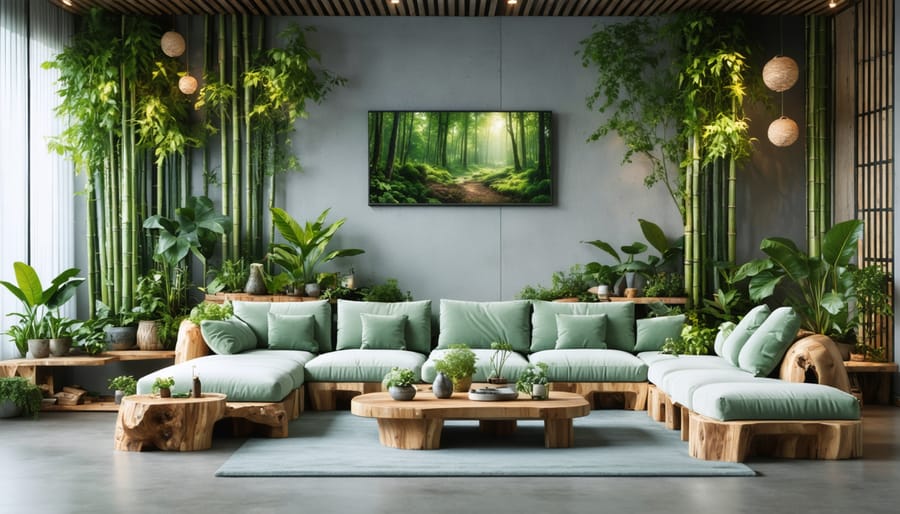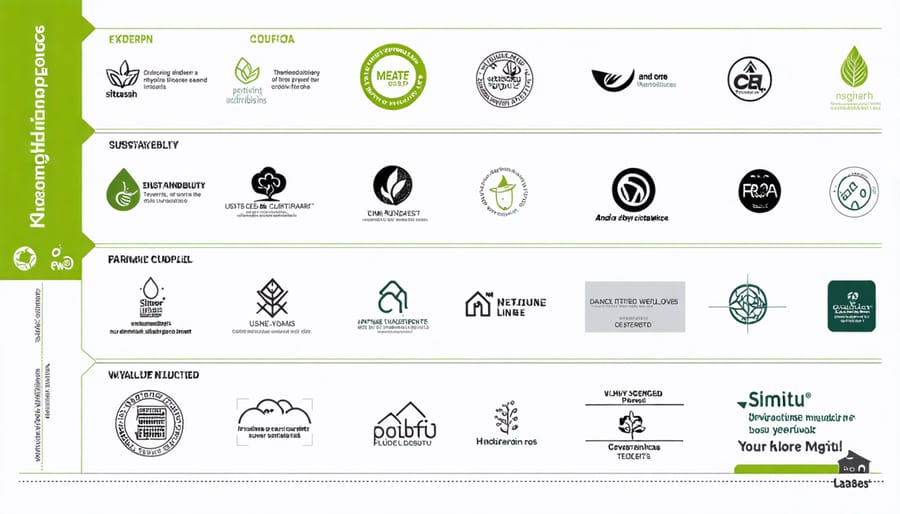
Sustainable Furniture: The Truth Behind Eco-Friendly Home Decor
Sustainable furniture revolutionizes how we furnish our spaces by prioritizing environmental responsibility without compromising style or functionality. From responsibly sourced materials to ethical manufacturing processes, this cornerstone of sustainable interior design represents a conscious choice to reduce our environmental footprint while creating beautiful, lasting pieces. Beyond just using eco-friendly materials, truly sustainable furniture encompasses the entire lifecycle – from forest to factory to your home, and eventually, to recycling or biodegradation. It considers worker welfare, minimizes carbon emissions during production and shipping, and often supports local economies through regional manufacturing. By choosing sustainable furniture, homeowners and designers aren’t just buying pieces; they’re investing in our planet’s future while creating healthier living spaces that tell a story of environmental stewardship and social responsibility.
What Makes Furniture Truly Sustainable?
Sustainable Materials and Their Sources
When it comes to eco-friendly furniture materials, manufacturers are increasingly turning to renewable and responsibly sourced options. Reclaimed wood leads the pack, giving new life to timber from old buildings, barns, and retired furniture pieces. This not only prevents deforestation but also adds character through unique patinas and grain patterns.
Bamboo has emerged as a sustainable superstar, growing up to 20 times faster than traditional hardwoods while offering excellent durability. Cork, harvested from the bark of cork oak trees without harming them, provides a renewable option for padding and decorative elements.
Recycled metals and plastics play a crucial role in sustainable furniture production. Aluminum and steel can be endlessly recycled without losing quality, while post-consumer plastics are transformed into durable outdoor furniture and decorative elements.
Natural fibers like organic cotton, hemp, and jute offer sustainable alternatives for upholstery and cushioning. These materials are grown with minimal environmental impact and are often biodegradable at the end of their lifecycle.
Manufacturers are also exploring innovative materials like mycelium (mushroom-based materials) and agricultural waste products. These alternatives transform what would typically be discarded into sturdy, eco-friendly furniture components.
When sourcing these materials, look for certifications like FSC (Forest Stewardship Council) for wood products, GOTS (Global Organic Textile Standard) for fabrics, and recycled content certifications. These ensure materials truly meet sustainability standards and haven’t been greenwashed.

Manufacturing Processes and Environmental Impact
The journey of sustainable furniture begins long before it reaches your home, starting with thoughtful manufacturing processes that prioritize environmental responsibility. Modern sustainable furniture makers employ innovative techniques that minimize waste, reduce energy consumption, and utilize sustainable materials throughout production.
Many manufacturers now implement closed-loop systems, where waste materials are recycled back into production or repurposed for other uses. Water-based finishes replace traditional chemical treatments, while energy-efficient machinery and solar-powered facilities reduce carbon footprints. Some companies even use locally-sourced materials to minimize transportation emissions and support regional economies.
The environmental impact of furniture production extends beyond the factory floor. Sustainable manufacturers carefully consider packaging, choosing biodegradable or recyclable materials instead of traditional plastic wrap. They often partner with local delivery services or optimize shipping routes to reduce transportation emissions.
Water conservation plays a crucial role, with many facilities implementing water recycling systems and drought-resistant landscaping. Advanced air filtration systems protect both workers and the environment from harmful particles, while proper waste management ensures that hazardous materials are disposed of responsibly.
Progressive manufacturers are also embracing digital technology to optimize production efficiency. Computer-aided design reduces material waste, while inventory management systems prevent overproduction. These smart manufacturing processes not only benefit the environment but often result in cost savings that can be passed on to consumers.
The most forward-thinking furniture makers maintain transparent documentation of their environmental impact, allowing consumers to make informed decisions about their purchases. This commitment to sustainability extends to worker welfare, ensuring safe working conditions and fair compensation throughout the supply chain.
Supply Chain Transparency in Sustainable Furniture
Certification Standards and Labels
When shopping for sustainable furniture, keep an eye out for trusted certification labels that verify environmental and social responsibility claims. The Forest Stewardship Council (FSC) certification is one of the most respected standards, ensuring wood comes from responsibly managed forests. Look for the FSC logo, which guarantees your furniture wasn’t made from illegally harvested timber.
Another important certification is GREENGUARD, which tests furniture for low chemical emissions, helping ensure better indoor air quality in your home. For upholstered pieces, the Global Organic Textile Standard (GOTS) certifies that fabrics are made from organic materials and processed sustainably.
The Sustainable Furnishings Council (SFC) membership is also worth noting – companies with this certification commit to environmental stewardship and transparency in their manufacturing processes. For recycled materials, look for certifications like Cradle to Cradle (C2C), which evaluates products on material health, material reuse, renewable energy use, water stewardship, and social fairness.
These certifications make it easier to verify sustainability claims and make informed purchasing decisions. While certified furniture might cost more initially, it often offers better quality and durability while supporting environmentally responsible manufacturing. Remember that not all sustainable furniture will carry every certification, but having one or more of these labels provides reliable assurance of a manufacturer’s commitment to sustainability.

Tracing Materials from Source to Store
Understanding where your furniture comes from is crucial for making sustainable choices. Modern supply chain tracking uses several methods to ensure transparency, from traditional paper documentation to advanced digital solutions. Many manufacturers now employ QR codes and RFID tags that let you trace materials from the forest or factory right to your living room.
The most responsible furniture makers maintain detailed records of their sourcing practices. They can tell you exactly which forests supplied their wood, which farms grew their cotton, and which facilities processed their materials. Look for companies that partner with certification bodies like the Forest Stewardship Council (FSC) or Global Organic Textile Standard (GOTS), as these organizations verify sustainable practices throughout the supply chain.
Technology has made tracking easier than ever. Some furniture brands now offer mobile apps where you can scan your product’s code and see its entire journey. This transparency helps ensure that sustainable practices are maintained at every step, from harvesting raw materials to final assembly.
When shopping, don’t hesitate to ask retailers about their supply chain documentation. Reputable companies should readily provide information about material sources, manufacturing locations, and transportation methods. This knowledge not only helps you make informed decisions but also supports businesses committed to environmental responsibility.
Making Smart Sustainable Furniture Choices
Questions to Ask Retailers
When shopping for sustainable furniture, don’t hesitate to ask retailers these important questions to ensure you’re making an eco-conscious purchase:
“What materials are used in this piece, and where do they come from?” This helps you verify if the materials are truly sustainable and ethically sourced.
“Does this furniture have any environmental certifications?” Look for recognized certifications like FSC (Forest Stewardship Council) or GREENGUARD.
“How long is this piece expected to last?” Quality sustainable furniture should be built to last, reducing the need for frequent replacements.
“What happens to this furniture at the end of its life?” Ask about recyclability and whether the retailer offers take-back programs.
“How is this furniture manufactured?” Inquire about the production process, including energy usage and waste management.
“What finish or treatments are used?” Ensure any stains, paints, or protective coatings are non-toxic and eco-friendly.
“Can you provide documentation about your supply chain?” Transparent retailers should be willing to share information about their sourcing and manufacturing practices.
“What packaging materials do you use?” Sustainable furniture should come with minimal, recyclable packaging.
Remember, a reputable sustainable furniture retailer should be happy to answer these questions and provide supporting documentation.

Red Flags and Green Lights
When shopping for sustainable furniture, watch out for vague claims like “eco-friendly” without specific certifications or details – this is a classic red flag. Be wary of companies that can’t explain their materials’ origins or manufacturing processes. Another warning sign is furniture marketed as sustainable but shipped from overseas with excessive packaging.
Green lights include transparent supply chain information and specific sustainability certifications like FSC (Forest Stewardship Council) or GREENGUARD. Look for furniture made from reclaimed materials, locally sourced wood, or rapidly renewable resources like bamboo. Companies that offer repair services, take-back programs, or provide detailed care instructions demonstrate genuine commitment to sustainability.
Positive indicators also include water-based finishes, zero-VOC materials, and minimal packaging made from recycled materials. Companies proud of their sustainable practices typically share detailed information about their environmental initiatives, manufacturing processes, and material sourcing on their websites or product labels.
Remember, truly sustainable furniture makers prioritize both environmental impact and product longevity, ensuring their pieces are built to last for generations.
Sustainable furniture represents a vital step toward creating an eco-friendly home while supporting responsible manufacturing practices. By choosing pieces made from renewable materials, certified sustainable wood, and recycled components, you’re helping protect our planet’s resources for future generations. Remember that sustainable furniture isn’t just about materials – it’s about durability, ethical production, and end-of-life considerations. Whether you’re furnishing a new home or gradually replacing existing pieces, every sustainable choice makes a difference. Start small by researching manufacturers’ environmental commitments, asking questions about production methods, and considering second-hand options. Your furniture choices can help create a healthier planet while bringing beauty and functionality to your living space. Make sustainability a priority in your next furniture purchase, and become part of the solution for a greener future.
